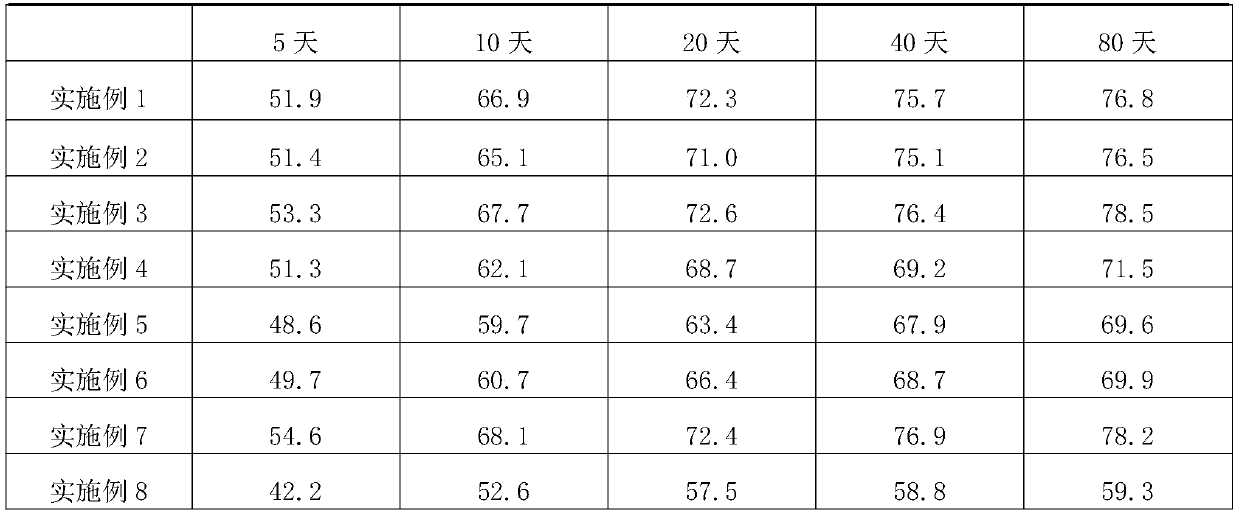Flocculant preparation method
A manufacturing method and flocculant technology, applied in the direction of flocculation/sedimentation water/sewage treatment, etc., can solve the problems of difficult storage of treatment agents, poor flocculation/degradation effect, etc., and achieve good flocculation effect, high turbidity removal rate, COD The effect of high removal rate
- Summary
- Abstract
- Description
- Claims
- Application Information
AI Technical Summary
Problems solved by technology
Method used
Image
Examples
Embodiment 1
[0062] The flocculant is prepared by the following method:
[0063] A. The cellulose is washed with water;
[0064] B. Immerse the cellulose in a solution with a pH of 7.5, extract for 1 hour, and wash twice with water;
[0065] C. Freeze the cellulose processed in step B in a -5°C environment;
[0066] D. Take out the cellulose after the treatment in step C, place it in an acidic solution with a pH of 6.5, soak it, and when it returns to 5°C, take it out and wash it twice;
[0067] E. drying and crushing the cellulose after step D is cleaned into powder;
[0068] F. Put the powder in 0°C water;
[0069] G. Keep the temperature at 0°C, stir, and slowly add alkaline reagents to adjust the pH to 7.3 to obtain a uniform and transparent solution;
[0070] H. Add the above solution into a vacuum sealed kettle, add an oxidizing agent, and heat up to 40° C. for 2 hours;
[0071] I. The solution treated in step H is rotary evaporated and dried.
Embodiment 2
[0073] The flocculant is prepared by the following method:
[0074] A. The cellulose is washed with water;
[0075] B. Immerse the cellulose in a solution with a pH of 8, extract for 2 hours, and wash with water for 3 times;
[0076] C. Freeze the cellulose processed in step B in a -10°C environment;
[0077]D. Take out the cellulose after the treatment in step C, place it in an acidic solution with a pH of 6.8, soak it, and when it returns to 10°C, take it out and wash it with water for 3 times;
[0078] E. drying and crushing the cellulose after step D is cleaned into powder;
[0079] F. Place the powder in water at 4°C;
[0080] G. Keep the temperature at 4°C, stir, and slowly add alkaline reagents to adjust the pH to 7.5 to obtain a uniform and transparent solution;
[0081] H. Put the above solution into a vacuum-sealed kettle, add an oxidizing agent, and heat up to 50° C. for 3 hours;
[0082] I. The solution treated in step H is rotary evaporated and dried.
Embodiment 3
[0084] The flocculant is prepared by the following method:
[0085] A. The cellulose is washed with water;
[0086] B. Immerse the cellulose in a solution with a pH of 7.8, extract for 1.5 hours, and wash with water for 3 times;
[0087] C. Freeze the cellulose processed in step B in a -7°C environment;
[0088] D. Take out the cellulose after the treatment in step C, place it in an acidic solution with a pH of 6.7, soak it, and when it returns to 7°C, take it out and wash it twice;
[0089] E. drying and crushing the cellulose after step D is cleaned into powder;
[0090] F. Put the powder in 2°C water;
[0091] G. Keep the temperature at 2°C, stir, and slowly add alkaline reagents to adjust the pH to 7.4 to obtain a uniform and transparent solution;
[0092] H. Put the above solution into a vacuum sealed kettle, add an oxidizing agent, and heat up to 45°C for 2.5 hours;
[0093] I. The solution treated in step H is rotary evaporated and dried.
PUM
 Login to View More
Login to View More Abstract
Description
Claims
Application Information
 Login to View More
Login to View More - R&D
- Intellectual Property
- Life Sciences
- Materials
- Tech Scout
- Unparalleled Data Quality
- Higher Quality Content
- 60% Fewer Hallucinations
Browse by: Latest US Patents, China's latest patents, Technical Efficacy Thesaurus, Application Domain, Technology Topic, Popular Technical Reports.
© 2025 PatSnap. All rights reserved.Legal|Privacy policy|Modern Slavery Act Transparency Statement|Sitemap|About US| Contact US: help@patsnap.com


